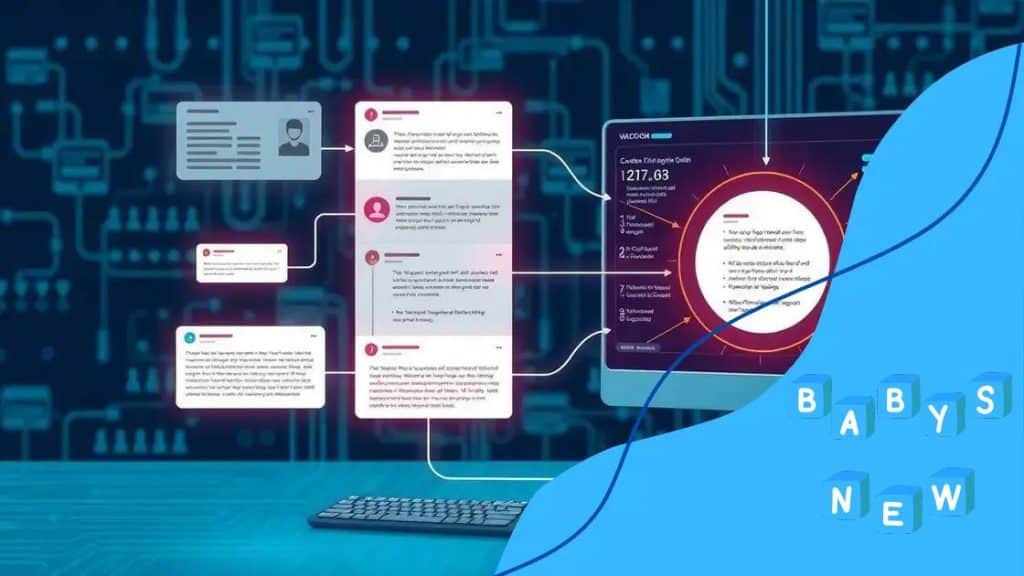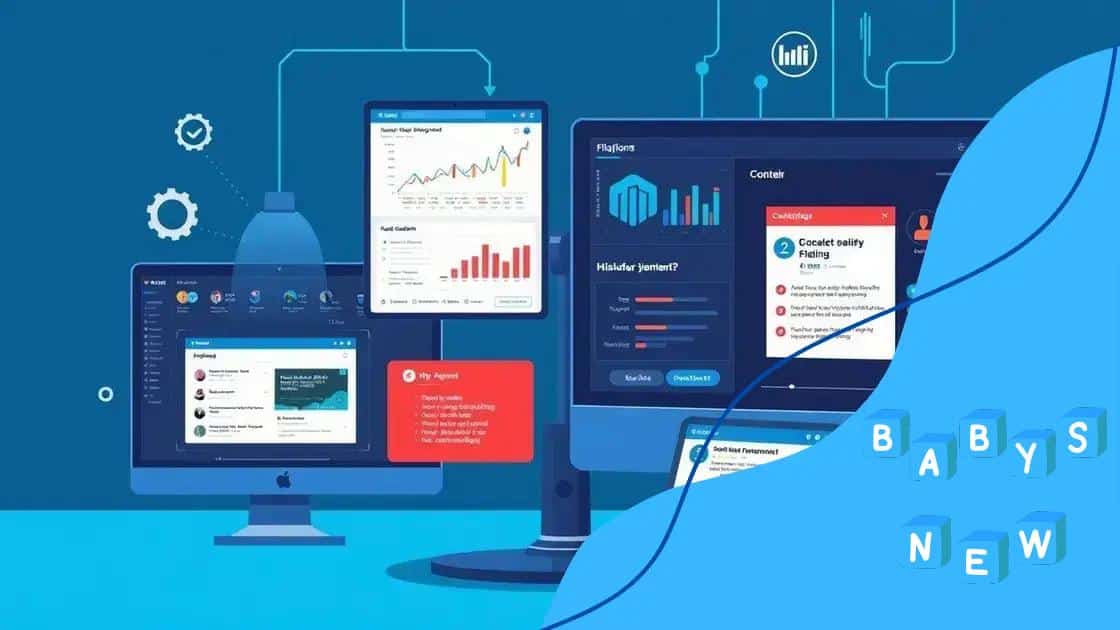AI in fighting online misinformation: a game changer

Advertisement
AI plays a crucial role in fighting online misinformation by rapidly analyzing data to detect false information, collaborating with human experts, and continuously improving through learning and ethical guidelines.
AI in fighting online misinformation has gained significant traction as a crucial tool for maintaining truth in today’s digital landscape. As we navigate through a sea of information, can AI really make a difference in combating false narratives?
Understanding the impact of online misinformation
Online misinformation is a major issue in today’s interconnected world. Understanding the impact of this problem is essential for creating effective solutions. In many cases, misinformation can shape public opinion and behavior, leading to harmful consequences for society.
When we talk about online misinformation, it refers to false or misleading information shared through various digital platforms. The spread of this content can be rapid and far-reaching, making it difficult for users to distinguish between what is true and what is false.
Advertisement
The consequences of misinformation
Misinformation can lead to confusion and distrust among people. It affects not only individuals but also communities and governments. Here are some key consequences:
- Polarization: Misinformation can divide communities, as people begin to rely on false information that aligns with their beliefs.
- Health risks: False health information can result in dangerous behaviors, such as ignoring vaccination guidelines or promoting unproven treatments.
- Economic impact: Businesses can suffer when misinformation leads to negative perceptions or boycotts.
Another aspect to consider is the role of social media platforms. These platforms can amplify misinformation due to their large and engaged user bases. Algorithm-driven content often prioritizes sensational headlines over accurate information. As people scroll through their feeds, they may encounter misleading claims, sometimes without realizing it.
To combat this issue, it is vital for users to cultivate critical thinking skills. This means questioning sources, verifying information, and being aware of their own biases. By doing so, individuals can help reduce the spread of misinformation in their circles.
Advertisement
The role of education is important as well. Schools and organizations are increasingly focusing on media literacy programs. These initiatives aim to equip people with the tools they need to navigate the complex digital information landscape effectively.
How AI detects and combats false information
Artificial intelligence (AI) plays a crucial role in detecting and combating false information. Its ability to process vast amounts of data quickly enables it to identify patterns and anomalies that humans might miss. This technology has transformed the way we address the problem of misinformation online.
AI systems utilize various methods to analyze content. They can scan text, images, and videos to determine whether the information is accurate. By leveraging advanced algorithms, AI identifies misleading claims more efficiently than traditional methods.
Techniques used by AI
There are several key techniques that AI employs in the fight against misinformation:
- Natural Language Processing (NLP): This enables AI to understand and interpret human language, allowing it to analyze the context and sentiment behind a statement.
- Machine Learning: These algorithms learn from data to improve their accuracy over time, which helps in distinguishing between true and false information.
- Image and Video Analysis: AI can assess multimedia content to spot deepfakes and manipulated visuals that may spread falsehoods.
Moreover, AI tools can monitor social media platforms, identifying how misinformation spreads across networks. By tracking shares and engagement, these tools help to understand the pathways of misinformation dissemination.
Combining these techniques allows AI not only to detect false claims but also to assess their potential impact on audiences. This insight enables platforms to take preventive measures, such as flagging or removing misleading content before it goes viral.
Collaboration between tech companies and researchers is vital to enhance these AI systems. By sharing data and best practices, they can create more effective solutions for combating misinformation across various contexts.
Case studies: AI solutions in action

In recent years, numerous case studies have showcased how AI solutions effectively combat misinformation. These real-world examples demonstrate the power of artificial intelligence in identifying and addressing false information online.
One impressive instance is Facebook’s use of AI algorithms. The platform utilizes machine learning to identify potentially misleading content. After flagging this content, human fact-checkers review it to verify its accuracy. This combination of technology and human oversight has significantly reduced the spread of **falsehoods** on the platform.
Another notable example
Twitter has also implemented AI-driven tools to tackle misinformation during critical events like elections or public health crises. By analyzing tweet patterns and user engagement, AI can detect emerging misinformation trends. This proactive approach helps the platform intervene before false claims gain traction.
- Real-time analysis: AI systems monitor tweets in real-time, allowing for immediate action against suspicious content.
- User education: by flagging tweets, Twitter prompts users to verify information before sharing it with others.
- Collaborations: Twitter works with external fact-checking organizations to enhance the reliability of flagged content.
A further example includes YouTube’s strategies for reducing misinformation related to health and wellness. The platform uses AI algorithms to analyze videos and recognize misleading claims. When discrepancies are found, YouTube displays authoritative information from reputable sources alongside the video.
Moreover, AI-powered tools are crucial in identifying deepfakes. For example, a number of universities and tech companies are developing systems that can detect altered images or videos. This technology plays a vital role in fighting misinformation by revealing manipulations that can mislead viewers.
The benefits of these AI solutions extend beyond immediate detection. They foster a more informed public by promoting critical thinking and encouraging users to question the validity of information. As AI technology continues to evolve, the impact on combating misinformation will only grow stronger.
Challenges faced when using AI against misinformation
Using AI to combat misinformation presents several challenges that can complicate its effectiveness. While AI tools have made strides in detecting false information, they are not foolproof.
One significant challenge is the accuracy of algorithms. AI requires vast amounts of data to learn from. If the training data has biases or is flawed, the AI may not correctly identify misinformation. This can lead to false positives, where true information gets flagged as false, or false negatives, where misleading information goes unchecked.
Understanding context
Another important issue is the contextual understanding of information. Misinformation often relies on taking facts out of context or manipulating the meaning of statements. AI systems can struggle with this nuance because they may lack the ability to fully comprehend language and cultural references in the same way humans do.
- Ambiguity in language: Words can have different meanings based on context. AI may misinterpret these variations.
- Subtle expressions: Sarcasm and humor can also pose problems for AI, as these often convey messages that are not straightforward.
- Cultural differences: AI systems may not recognize certain local beliefs or practices, leading to misunderstandings.
Additionally, the constantly evolving nature of misinformation is another hurdle. New tactics emerge regularly as bad actors adapt to existing detection methods. This means AI models must continuously update to stay effective, which can be resource-intensive and time-consuming.
Data privacy concerns also arise. To train AI models, platforms must sometimes collect vast amounts of user data. This raises ethical questions about surveillance and consent. Users may be hesitant to share information, limiting the data available to creators of AI models.
Finally, there is the potential for misuse of AI technology itself. Those with malicious intent may leverage AI tools to create deepfakes or craft increasingly convincing misinformation. This arms race between misinformation and detection becomes a critical issue for society.
The future of AI in information integrity
The future of AI in information integrity looks promising as technology continues to evolve. Innovations in artificial intelligence are paving the way for more effective tools to combat misinformation. As digital landscapes change, AI will play a crucial role in ensuring the accuracy of online content.
One important area is the development of more sophisticated algorithms capable of understanding context better. These advancements will help AI discern whether information is misleading based on the nuances of language and the credibility of sources. By improving on these aspects, AI can provide a more accurate assessment of what is reliable information.
Collaboration with experts
Moreover, the future of AI lies in collaboration with human experts. Combining AI’s speed and computational power with human intuition and critical thinking creates a potent strategy against misinformation. Professionals in journalism and fact-checking will work alongside AI systems, ensuring a balanced approach to identifying false claims.
- Continuous learning: AI will likely adopt mechanisms for continual learning, refining its processes as new misinformation strategies emerge.
- Ethical frameworks: Developing ethical guidelines for AI usage is essential. This will ensure that AI tools are used responsibly and transparent methods are in place to build trust.
- User empowerment: Future AI systems may focus on educating users to better recognize misinformation themselves. This can foster a culture of critical consumption of information.
In addition, privacy measures will play an essential role in AI’s evolution. As data protection becomes more important, future AI tools must uphold user privacy while still being effective in combating misinformation. This balance will be key to maintaining public trust in AI technologies.
Finally, as AI continues to advance, the hope is that it not only fights misinformation but also helps create a more informed society. By encouraging a culture of fact-checking and responsible sharing, AI can contribute to fostering a healthy information ecosystem for all.
FAQ – Frequently Asked Questions about AI in Fighting Misinformation
How does AI help in detecting misinformation?
AI analyzes large volumes of data quickly to identify patterns and anomalies, making it effective at detecting potentially false information.
What challenges does AI face in combating misinformation?
AI struggles with understanding context, language nuances, and may produce false positives or negatives if trained on biased data.
Can AI work with human fact-checkers?
Yes, collaboration between AI and human experts enhances the accuracy of misinformation detection as AI provides quick insights while humans provide context.
What is the future of AI in ensuring information integrity?
The future includes improving algorithms for better understanding, creating ethical guidelines, and empowering users to recognize misinformation.





